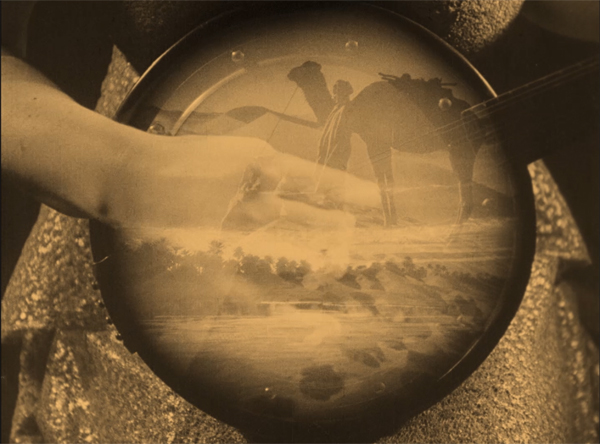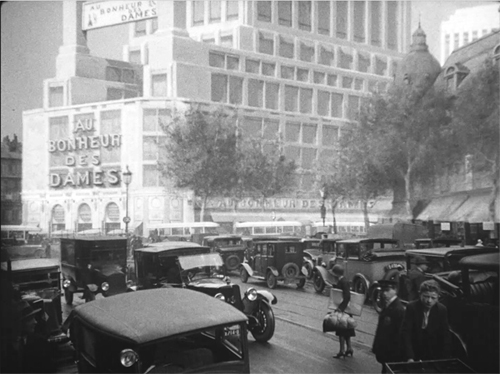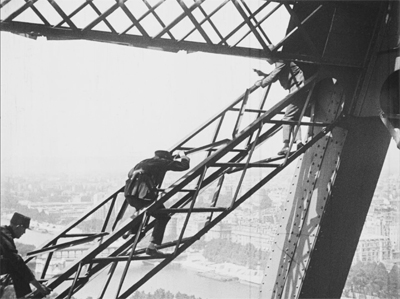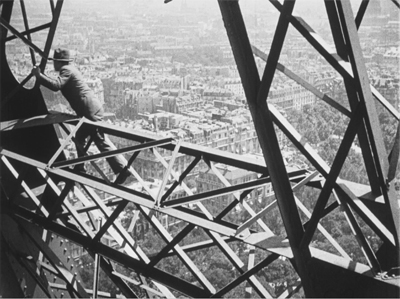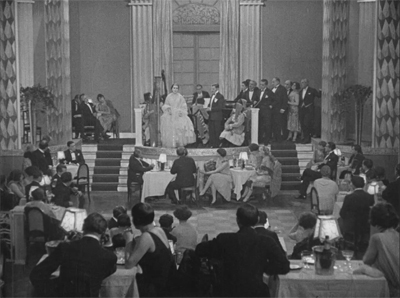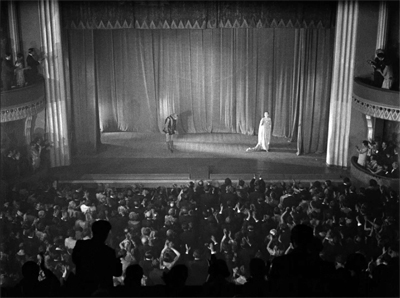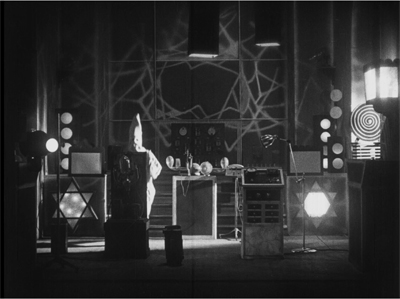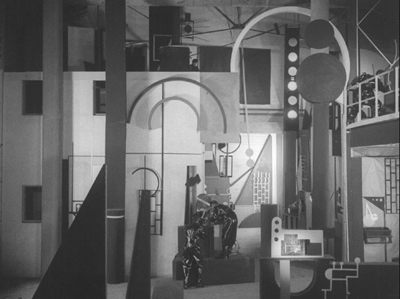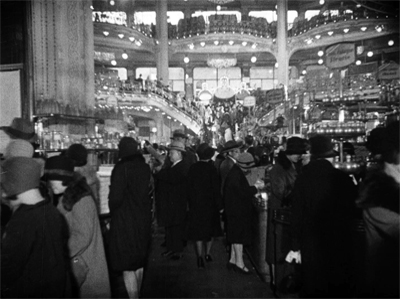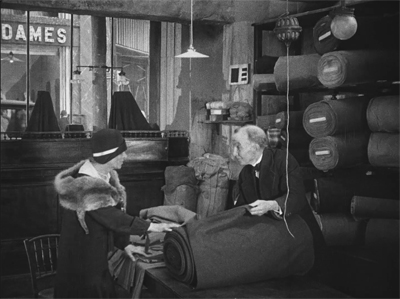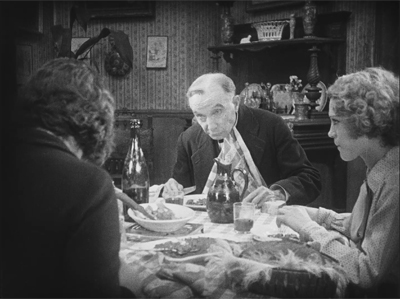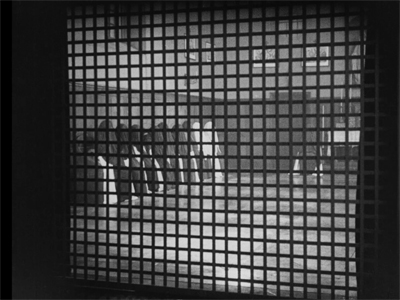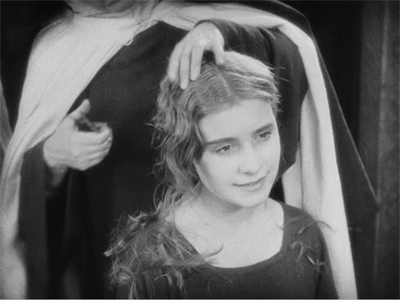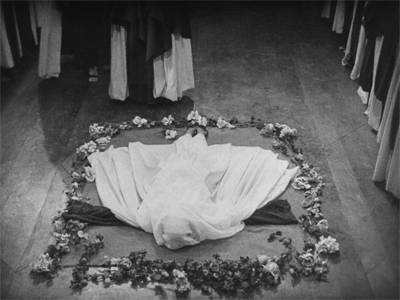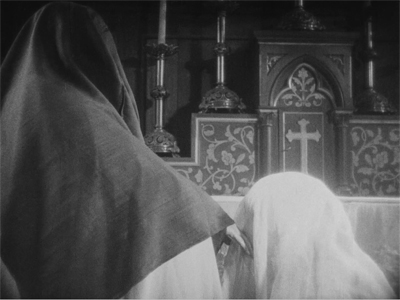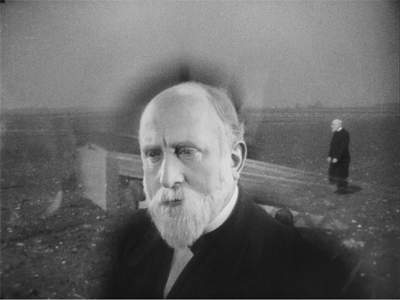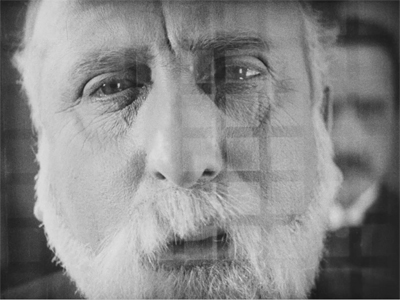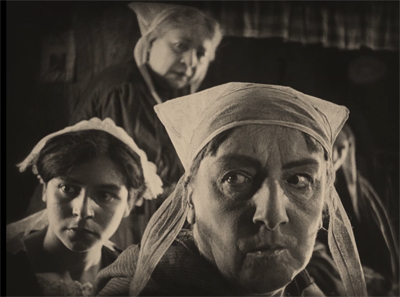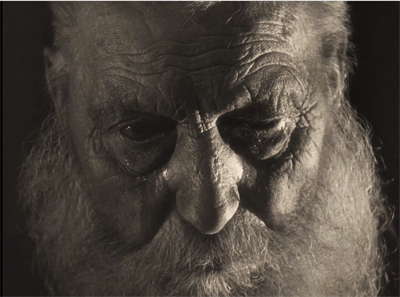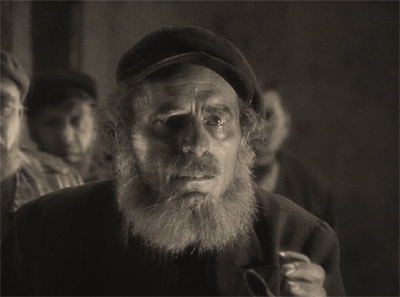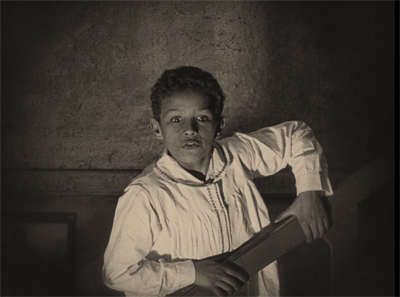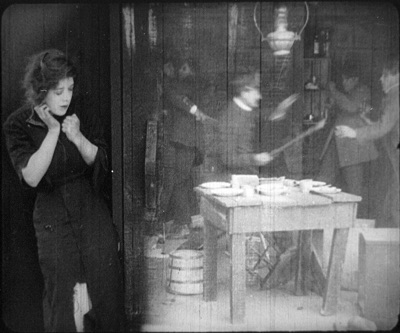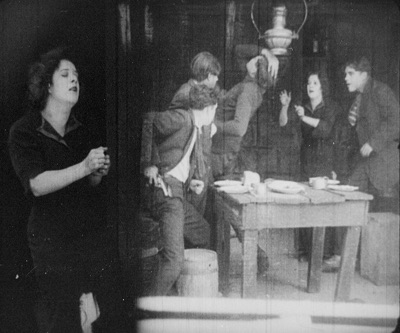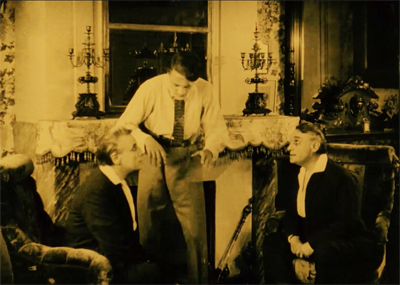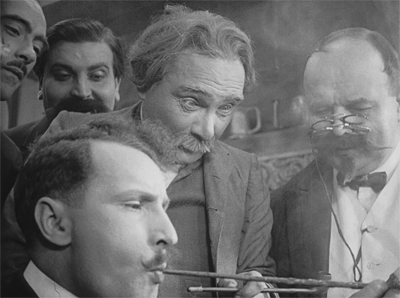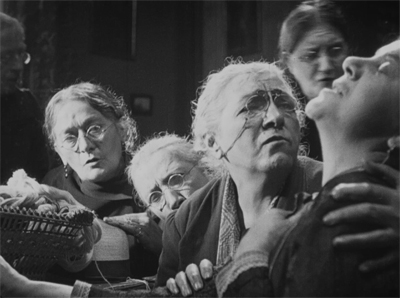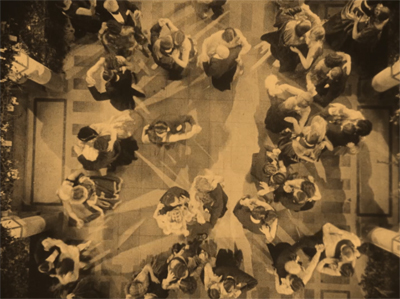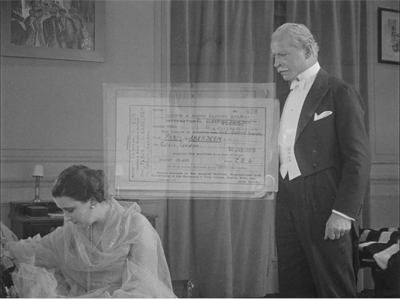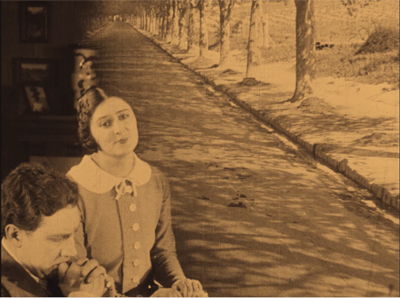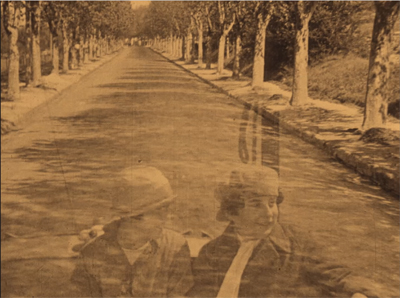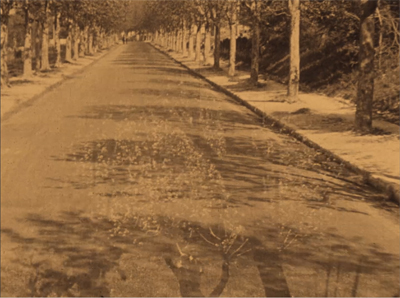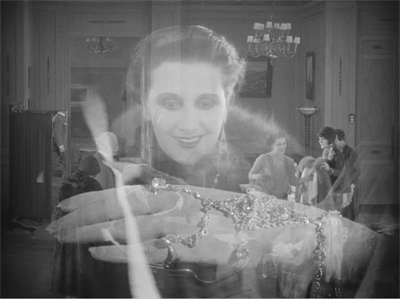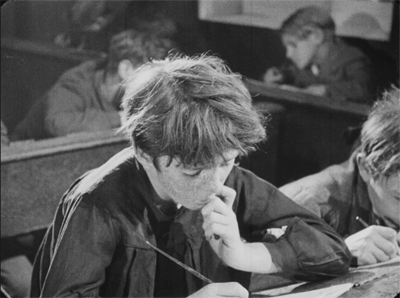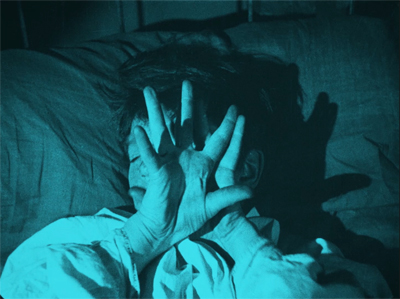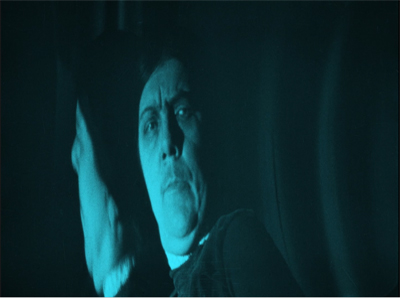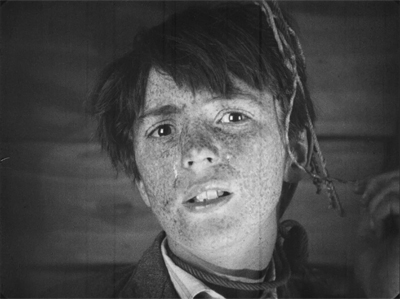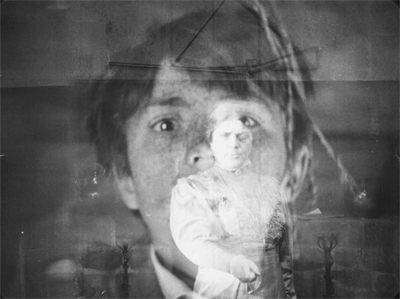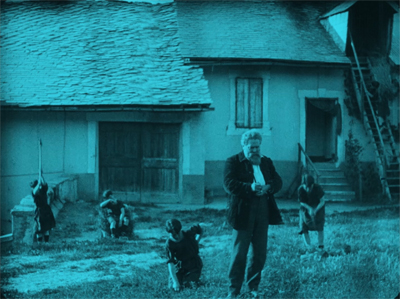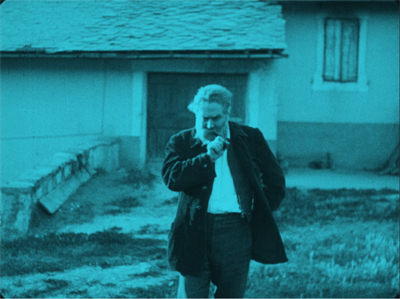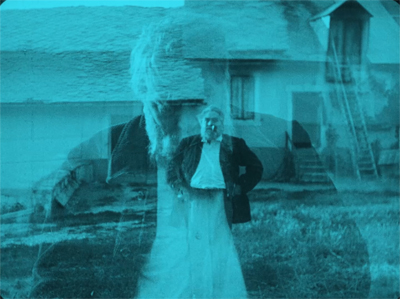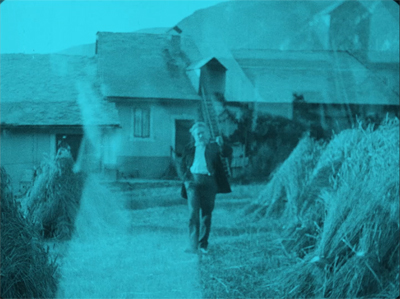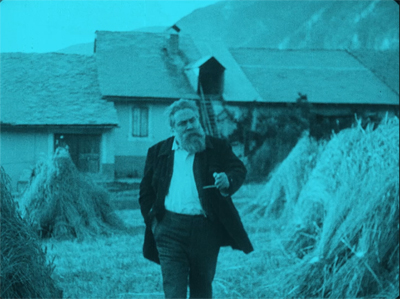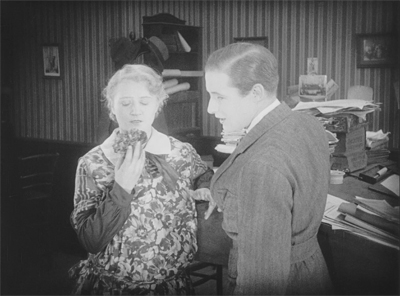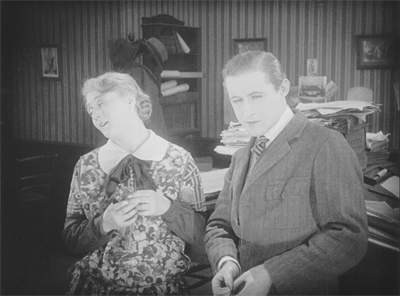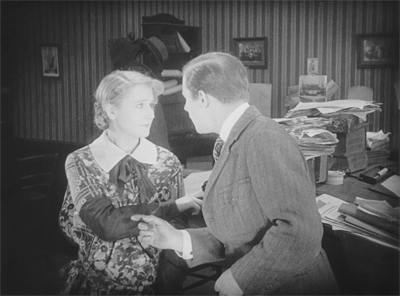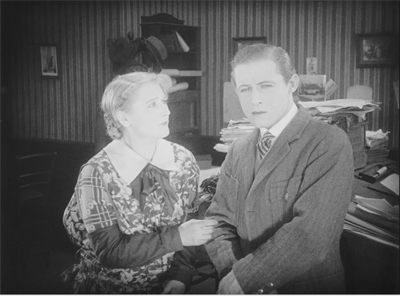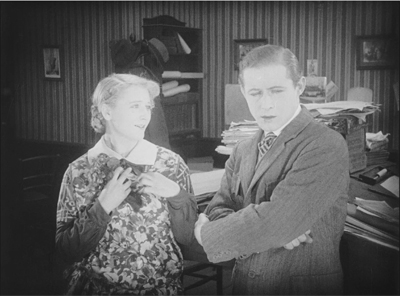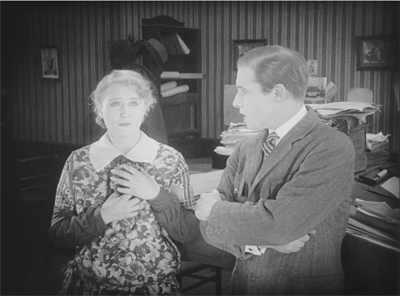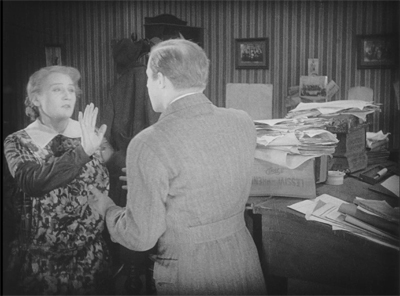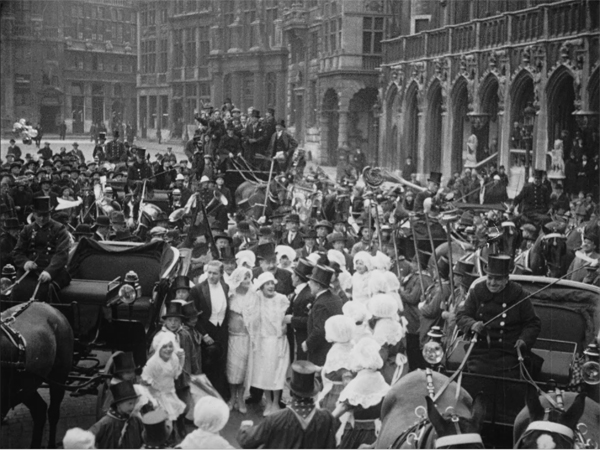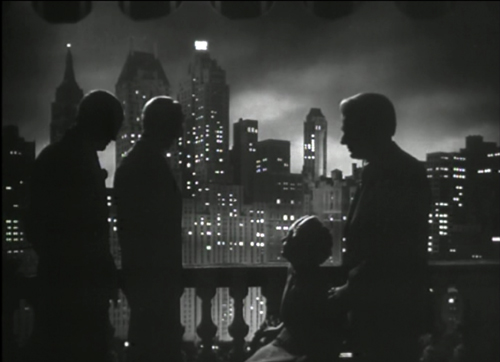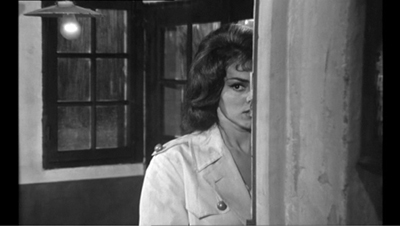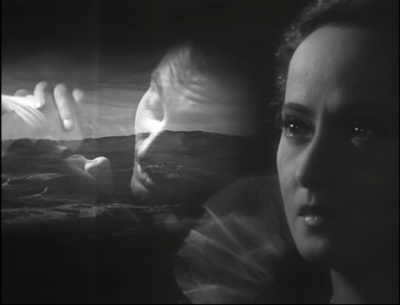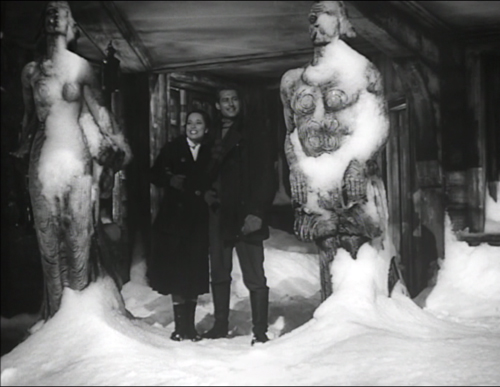Archive for the 'Directors: Duvivier' Category
When the image ruled: Julien Duvivier in the silent era
Maman colibri (Mother Hummingbird, 1930).
DB here:
Rewind the tape of film history. What if cinema had been invented as a perfect audiovisual medium, with images exactly synchronized with sound? What would the evolution of film form and style have been like?
Actually, Edison and other early inventors wanted sound to accompany the picture. Technical obstacles to sync sound initially proved too strong, and the fact that the public approved of the silent image led to a delay in fulfilling what André Bazin called “the myth of total cinema.”
It’s long been felt that this delay was a good thing for the artistic development of the medium. Perfect image/sound coordination would have led filmmakers to a line of least resistance, a simple reliance on recording what was taking place in front of the camera. The absence of dialogue forced filmmakers to develop techniques of visual storytelling. “The time of the image,” thundered Abel Gance, “has come!”
Some film techniques were borrowed from theatre and painting, but others became identified closely with the moving image. Techniques such as camera movement, analytical cutting, and rhythmic crosscutting, have analogs in other arts but remain distinctly “cinematic” (chiefly because of cinema’s ability to control duration). During the 1910s and 1920s, filmmakers refined pictorial narrative in ways that couldn’t have been foreseen earlier, and avant-garde movements showed that the new medium had remarkable abstract and non-narrative possibilities as well.
Because of all this, it seemed that sync sound came along just when the silent cinema had reached an expressive peak. By then, people knew the powers of the moving image, and so could integrate sound with it to create an audiovisual art form.
I think there’s a lot to be said for this viewpoint, though it was often used as a cudgel to beat early talkies as “uncinematic.” There’s no denying that many filmmakers who made outstanding silent films, from Hitchcock, Lang, and Ford to Lubitsch, Eisenstein, and Renoir, managed to retain pictorial richness while relying on the unique contributions sound could make. In a teaching exercise, Eisenstein asked students to plan the filming of the assassination of Julius Caesar as a silent film, and then go back and reconceive it as a sound film. That way, the new synthesis could exploit the strengths of both ingredients.
 Julien Duvivier’s silent films are good examples of the push toward maximal expressivity by means of visuals. He accepted the coming of sound, even welcoming color and depth, but by then he had already accepted the 1920s urge toward an overwhelming pictorial experience. At one level, he saw the need for spectacle–either shooting on striking locations, employing masses of actors, or creating flamboyant studio sets. At another level, the visual storytelling could be more inward-turning. How could moving images illuminate the thoughts and feelings of characters, the access to minds given through language in prose fiction and on stage? We can see in Duvivier’s late silent work a pressure in both directions: a love of eye-smiting locations either found or fabricated, and an urge to plunge into characters’ minds at every moment.
Julien Duvivier’s silent films are good examples of the push toward maximal expressivity by means of visuals. He accepted the coming of sound, even welcoming color and depth, but by then he had already accepted the 1920s urge toward an overwhelming pictorial experience. At one level, he saw the need for spectacle–either shooting on striking locations, employing masses of actors, or creating flamboyant studio sets. At another level, the visual storytelling could be more inward-turning. How could moving images illuminate the thoughts and feelings of characters, the access to minds given through language in prose fiction and on stage? We can see in Duvivier’s late silent work a pressure in both directions: a love of eye-smiting locations either found or fabricated, and an urge to plunge into characters’ minds at every moment.
These revelations come courtesy of Flicker Alley’s massive collection of nine of his late 1920s features, all beautifully restored by the dedicated team at Lobster Films. Poil de Carotte (1926), the earliest item in the box, shows a filmmaker utterly in command of the resources of the “mature silent cinema.”
Most of the films between that and Au bonheur des dames (1930) have been largely unknown and forgotten, and their revelation here is unlikely to add another masterpiece to his career log. But they’re very impressive for revealing the diversity and ambitions of mainstream French cinema of the 1920s. Moreover, Duvivier was prepared to carry a commitment to pictorial storytelling to striking extremes.
Eye candy, natural and artificial
Duvivier’s first film, Halcedama (1919; not in this collection), a French “Western,” made extensive use of the rugged terrain of the Corrèze region, “the savage heart of France,” according to a title. Extreme long shots (akin to those in Feuillade’s Tih Minh) let mountains and valleys dwarf the characters. The 1920s films tend to be melodramas, but they too exploit locations with expansive production values.
Before moving to cosmopolitan scenes, Le Tourbillon de Paris (1928)’s opening scenes give off a palpable sense of cold in their bleak display of a man struggling through the snow in Tignes, in the French Alps. The same regional realism is present in La Divine Croisière (1929), shot on location in several coastal cities.
L’Agonie de Jérusalem: Revelation (1927) tells of an anarchist who rejects bourgeois comforts, including “paternal power,” and agitates for world revolution. When he’s blinded, he returns to the family home in Jerusalem. There he undergoes a conversion through identifying with Christ’s suffering and is miraculously cured. Duvivier took the production to Jerusalem, and the film features impressive scenes of the area, including the Wailing Wall and the Garden of Gethsemane.
For Maman Colibri (1930), Duvivier’s heroine, a woman who leaves her husband for a soldier young enough to be her son, follows him to his post in Algeria. The film exploits both desert landscapes and the sumptuous gardens of the Villa Arthur in Algiers. Closer to home, but still carrying the whiff of the picturesque, was Le Mariage de Mlle Beulemans (1927), a comedy about rivalry between brewers. The film begins with a montage of Belgian cities and their landmarks, culminating in a documentary montage of Brussels. The film is bookended by a double wedding at the city’s splendid Grand Place.
Probably the location shooting that will most attract a viewer today is the climactic sequence of Duvivier’s parody of Feuillade serials, Le Mystère de la Tour Eiffel (1927). It consists of a long chase up the girders of the tower, with actors scrambling after one another in vertigo-inducing shots.
As with Tih Minh, you have to marvel at the acrobatic skill and sheer guts of the performers.
Duvivier also took advantage of the resources of well-endowed French studios, which had yielded impressive set design in Gance’s Napoleon (1927), L’Herbier’s L’Argent (1928), and Dreyer’s Passion de Jeanne d’Arc (1928). Le Tourbillon de Paris, tracing the return of a stage diva to the city she loves, shows her reentry into the haute monde in a huge nightclub scene. This is later matched by her triumph in before a theatre audience.
More stylized sets, in a comic vein, characterize the Antenna gang in Mystère de la Tour Eiffel. They use , the Tower to transmit coded messages to their agents. The gang headquarters may be a down-market parody of Léger’s modernist sets of L’Herbier’s L’Inhumaine (1924).
Probably the most famous achievement of Duvivier’s set design is the staggering department-store set in Au Bonheur des Dames, Zola’s story of big business crushing local shops. Sweeping tracking and crane shots enhance the scale of Au Bonheur des Dames, modeled on the Galeries Lafayette (where a few shots were taken as well). The film contrasts the vista of the main shopping area with the cramped store of the fabric merchant Baudu.
The same difference emerges in the broad layout of the office of store’s boss Mouret and Baudu’s pinched apartment, built as a complete set of rooms.
Yet the sets can be less ostentatious and still powerfully functional. The simple, geometric grids and figure placements of the investiture scene in La Vie miraculeuse de Thérèse Martin (1929) gather force through their precise articulation of the stages of the heroine’s acceptance into the sisterhood.
In this twenty-minute sequence, details of gesture and position exude respect for the rigors of ritual and the sincerity of the girl. Duvivier’s calm precision reminds me of scenes in Bresson’s Anges du péché. At the same time, the impersonality of the ceremony is heightened by cutaways to Thérèse’s father, at once pious and regretful; with her novitiate, he will die alone. For him, Duvivier adds Impressionist flourishes to emphasize that the grille shuts him off from her.
Such scenes create a sort of “intimate spectacle” that goes beyond sheer scale.
In a fine crowd scene in La Divine Croisière, Duvivier deploys expressive detail within a mass of people. The predatory capitalist Kerjean has ordered a defective ship to sail, and the townsfolk fear that it has been lost. Simone, a courageous young woman, calls a meeting in which she asks them to cease mourning and set out to look for the sailors. In a brief montage reminiscent of the cream-separator sequence in Eisenstein’s Old and New, close-ups show the villagers gathering hope under Simone’s visionary appeal.
With this sort of intimacy, however, we move close to the second pictorial strategy that characterizes Duvivier and many of his peers: picturing the workings of the mind.
Getting inside
Kristin has pointed out that the 1910s were an era when many filmmakers wanted to go beyond simply creating a coherent story by adding expressive dimensions to the action. Many American films of the period try to illustrate characters’ thoughts, chiefly through flashbacks. There were more elaborate experiments as well, with attempts to portray dreams, hallucinations, and even alternative courses of action. (Some examples here.) In The Gangsters and the Girl (1914), a young woman imagines two consequences of a robbery.
Halcedama had, like many other French films, incorporated simple subjective techniques like these. The looming figure of the protagonist’s dead father interrupts several scenes, and one scene multiplies the presence of the man the protagonist has come to kill.
The early 1920s saw French filmmakers eagerly exploring other resources. Duvivier’s films are much of their time in their inclusion of wide-angle shots with big foregrounds, a great range of camera angles, freely moving camerawork (including crane shots), heavy use of superimposition and dissolves, and a multiplication of cuts, often very fast-paced.
Abel Gance’s La Roue (1922) and Jean Epstein’s Coeur fidèle (1923) crystallized these possibilities, and other filmmakers felt free to flaunt pictorial display. Many of these devices were put in the service of enhanced subjectivity.
In scene after scene, Duvivier dwells on the moment by plunging into characters’ reactions to the scene, given not through dialogue but through imagery. One of his favorite devices is the superimposition–not as a single item, as in The Gangsters and the Girl, but as a flurry of images melting into one another, suggesting a stream of consciousness. In L’Agonie de Jérusalem, Alice recalls the childhood she shared with Jean, as images rolling along a road.
The heroine of Le Tourbillon de Paris is dazzled by the array of jewels and dresses her husband offers her, and the heroine of Maman Colibri is captivated by her dance partner.
Poil de Carotte is a virtual anthology of ways of conveying mental states. This tale of child abuse probes the fear and despair François feels by being trapped in a family full of hate. The opening uses superimpositions of family members to show how it’s painful for him to write an essay about them.
His cruel mother haunts his dreams, and her attacks on him are given in distorted imagery.
As he rigs up a noose with which to hang himself, we get a rapid montage, in superimposition, of memories of ill treatment.
Nearly every film is packed with these inserted passages, which seek to deepen the drama without use of intertitles. Today they look old-fashioned, even though our films continue to use them. Back then they may have become a bit tiresome. Serge Bromberg’s text for the Flicker Alley booklet quotes a 1930 review:
Why does Julien Duvivier sometimes insist on techniques that seem obsolete today? Overprints [superimpositions] and special lenses no longer surprise us.
When they work best, I think, it’s because they find fresh material that allows them to unexpectedly expand the moment of a scene. For example, François’s father is not so much cruel as indifferent to the boy. His gradual realization that the mother is working the boy like a dog is given two ways. First, a multiple-image shot shows several versions of his son busy in the garden.
Then a series of dissolves following the father’s advance to the camera shows the sheaves now sprung up in profusion–all as a result of the boy’s labor.
Still, Duvivier was able to probe minds without such devices. The village meeting in La Divine Croisière, mentioned above, is an example. So too is a little bit of byplay in Le Mariage de Mlle Beulemans.
Albert, a Parisian, is working in a Brussels brewery and has fallen in love with the boss’s daughter Suzanne. He leaves a corsage on her desk while she’s out. Seraphin, her shady fiancé, has found it there and, when she returns, offers it to her as his own gift. When Albert returns and finds her wearing it, he assumes that he’s won her affection–until he realizes Seraphin’s ploy. Duvivier could have played this out in a series of superimpositions in which Albert imagines her finding it, thinking of him, and wearing it for his sake. Instead, it’s left to the actors in a simple two-shot.
Albert sees her caress the corsage and he’s pleased. But then she says Seraphin gave it to her. There’s no dialogue title. She turns her head to the left to indicate he’s outside.
Albert starts to claim credit, but thinks the better of it and turns away. She notices and asks if he gave it to her.
He doesn’t admit it, but she realizes the truth.
As she ponders Seraphin’s deceit, Albert understands. He approaches, but she wards him off, still believing she must marry her fiancé.
Admittedly, this little pas de deux takes place after a dialogue in which Albert imagines all the slights he’s suffered as an outsider to the company, and before a lyrical passage in which he conjures up finding a flower in a lake. Duvivier couldn’t resist expanding the situation through his usual means. But the understated playing of the pair, without any verbal explanation, shows that he didn’t always need flashy visualizations to evoke characters’ changing reactions to a situation.
Duvivier remained active until his death in 1967, racking up an astonishing seventy-one features. There are plenty I have yet to see, but I’ll just signal some landmarks. Although he has remained most famous for his two Poetic Realist achievements, La Belle équipe (1936) and Pépé le Moko (1937), his accomplishments were more wide-ranging. Allô Berlin? Ici Paris! (1932) is a charming early sound comedy, and Un Carnet de bal (1937) and La Fin du jour (1939) won acclaim around the world. In Reinventing Hollywood I called attention to his significant American work: Lydia (1941), Tales of Manhattan (1942), and Flesh and Fantasy (1943). His powerful Simenon adaptation Panique (1946) is admirable, as are the lighter-hearted Sous le ciel de Paris (1951) and La Fête à Henriette (1952). Marie-Octobre (1959) is an interesting experiment in the three unities. And his later policiers have their supporters, especially Voici les temps des assassins (1956). Attacked by the Nouvelle Vague as a fossilized academic, he has reemerged as a robust example of the enduring force of French film tradition. The Lobster/Flicker Alley box confirms him as a sturdy storyteller and an ambitious pictorialist.
Halcedama is available on the Cinémathèque Française website, among many other discoveries. Gance’s broadside, “Le Temps de l’image est venu!” is in L’Art cinématographique II, ed. Léon Pierre-Quint, Abel Gance, Lionel Landry, and Germaine Dulac (Paris: Félix Alcan, 1927), 83-102. It is available in an Arno Press reprint (New York, 1970).
The best book on French silent film is Richard Abel’s magnificent, encyclopedic French Cinema: The First Wave, 1915-1929. A very complete account of Impressionist cinema is in Noureddine Ghali, L’Avant-garde Cinématographique en France dans les années vingt: Idées, conceptions, théories (Paris: Experimental, 1995). Kristin’s argument about the 1910s is set forth in “The International Exploration of Cinematic Expressivity,” in Film and the First World War, ed. Karel Dibbets and Bert Hogenkamp (Amsterdam University Press, 1995), 65-85.
Kristin picked Au Bonheur des dames as one of the best films of 1930. I discuss Lydia in a Criterion Channel installment, teased here. French Impressionism has remained a powerful, if usually indirect, influence on modern directors–for example, Scorsese.
Le Mariage de Mlle Beulemans (1927).
Lovelorn LYDIA: A new installment on the Criterion Channel
DB here:
In the fading days of FilmStruck, Kristin and Jeff and I are looking forward to continuing our Observations on Film Art series on the new version of the Criterion Channel in the spring. (If you’re in the areas served, US and Canada, you can sign up here. I did already. Quick and easy.)
In the meantime, our final entry on the FilmStruck platform is going live on Monday, 19 November. There I consider Julien Duvivier’s Lydia (1941) as an example of the power of flashback storytelling.
I talked about the film in Reinventing Hollywood as part of the massive 1940s revival of this technique. Critics’ long-standing emphasis on film noir has led us to think that that trend epitomized flashback construction, but actually the technique is almost completely general. In the book, I consider several “women’s pictures” that employ it: Kitty Foyle (1940), The Affairs of Susan (1945), The Locket (1946; also discussed here), and Lydia. The Criterion series allows me to illustrate more concretely how Duvivier and his colleagues tell the story of a woman captured by passion and moving into old age almost (but not completely) disillusioned.
Working on the book and the entry made me better appreciate a director I’d neglected. Like everybody else, I had had a high regard for La Belle Équipe (1936) and Pépé le Moko (1937), and I had seen and liked his Simenon adaptation Panique (1946). A special favorite of mine is his cross-border comedy about switchboard romances, Allo Berlin? Ici Paris! with clever sound work quite advanced for 1931. Beyond Lydia, other Hollywood efforts of his proved important for Reinventing Hollywood. Tales of Manhattan (1942) and Flesh and Fantasy (1943) are adroit instances of the episode film, that format using what I called “block construction.”
Duvivier was sometimes disdained by the younger generation as an old-guard academic, but I’ve come to see him as a rather interesting experimentalist. He tried out a day-in-the-life network narrative (Sous le ciel de Paris, 1951), a charming what-if comedy about screenwriting (La Fête à Henriette, 1952), and a solid Gabin polar (Voici les temps des assassins, 1954). His suspense drama Marie-Octobre (1959), might seem overly theatrical because it has a Rope-like confinement to a single evening, an anniversary dinner for survivors of the Resistance, but it’s actually based on a novel and gains tension from its almost real-time duration. It showcases a range of major stars (Darrieux, Blier, Reggiani, Ventura) and boasts one of the most dazzling parlor sets I’ve seen in a long while.
Among his thrillers adapted from English authors there’s the curious Chabrolian exercise, La Chambre ardente (1962), based on a John Dickson Carr novel, and the seedy Chair de poule (aka Highway Pickup, 1963, below) from James Hadley Chase.
I’m sure there are clunkers and potboilers among his dozens of titles, but it’s a pretty distinguished career, running back to the silent cinema and his early classic Poil de carotte (1925). His department-store drama, Au Bonheur des Dames (1930), exemplifies bravura silent-film style at its height. He even remade The Golem (1936).
For me, Lydia encapsulates the ambitions typical of Duvivier and 1940s Hollywood. The film could count as a rewrite of Carnet du bal (1937), his story of a woman who revisits the men who danced with her one night in her youth. That plot might seem to demand a string of flashbacks, but instead it’s all played in the present. Her confrontation with what the dashing young men have become leads to a string of extraordinary encounters enacted by top players of the day (Rosay, Bauer, Fernandel, Raimu, Jouvet, Sylvie). The melancholy tone, involving a mournful devotion to impossible love, is reminiscent of Dreyer’s Gertrud.
Lydia takes the alternative option of actually dramatizing the memories of the heroine and her three lovers as they reflect on the old days. The flashbacks are daringly introduced with straight cuts and curt sound bridges; a couple of scenes use slow-motion for the past, a very unusual choice for the period. The soundtrack is unusually lush, with the brilliant Miklós Rózsa supplying lilting waltzes and even some early electronic effects. For a bold montage merging Lydia’s passion with that of the raging sea, he came up with a fierce piano concerto.
The film plays on the disparities of time and memory in a rather modern way. Flashbacks contradict one another, and what we see doesn’t always match what the voice-over tells us. Lydia in the present seems to whisper advice to the girl we see in the past, as if she’s watching the film along with us. The climax is quietly devastating: the twist was demanded by censorship, but producer Alexander Korda claimed, rightly, that it improved the film. We’re left wondering how much to trust Lydia’s memory of her idealized affair.
One thing that didn’t make it into our entry: Discussion of the peculiar cottage where Lydia and her lover Richard share their passionate idyll. It seems to be built out of the bodies of big naked people. So I share one image with you, below.
Apart from that, I hope you get to play my installment, in the waning days of FilmStruck, or maybe cached on the new Criterion Channel in the spring. You can sign up for that streaming service here, and the sooner you do it, the easier it will be to launch.
We’re grateful as usual to Peter Becker, Kim Hendrickson, Grant Delin, and the whole Criterion team, and to Erik Gunneson of the UW Department of Communication Arts. Special thanks to Daniel Reis, editor of most of our installments, whose adroit cutting strengthened them enormously. (The Lydia entry masterfully stitches together disparate sequences using Lydia’s dialogue as a voice-over.) Other entries were cut by the equally gifted Clyde Folley. Thanks as well to Kelley Conway and Phillip Lopate for conversations about Duvivier.
Criterion has served Duvivier well, offering several of his works on DVD.
A list of our Observations installments to date is here.
Lydia (1941): A house embellished with ships’ figureheads becomes the lovers’ sanctuary.












